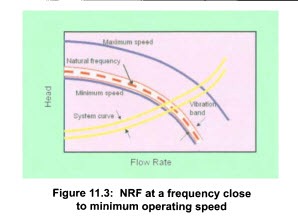Power drive system integration
A motor with its control becomes a power drive system, which may be fixed or variable speed design. This section considers the integration of a variable speed system.
When considering using a variable speed drive with a motor, great care must be taken to match the electrical characteristics of the motor and
drive, otherwise the risk of premature failure is introduced into the system. The evaluation must consider the pump, motor and drive in combination.
The motor manufacturer will generally be able to give details of the acceptable operating envelope for a specific motor, Figure 10.1 shows a typical curve . This envelope may well vary from frame to frame , and is especially important when a motor is used in a hazardous area. There are no definitive rules that can be applied to all motors.
In general, little or no de-rating is required with rotodynamic pumps.
It must also be remembered that the isothermal guidelines apply to continuous operation and as the thermal time constant of the motor is reasonably long, the full torque capability will be available intermittently for starting and acceleration. The level of torque is directly related to the current passing, and is therefore governed by the converter .
With a high inertia load, such as a pump with a flywheel, a VFD is able to control the starting current and allow the accelerating torque to be sustained for longer than for a direct-on-line start.
PD pumps with their constant torque characteristic are more likely to require special consideration for reduced speed operation. In addition, the levels of starting torque required need to be considered , especially with progressive cavity pumps.
